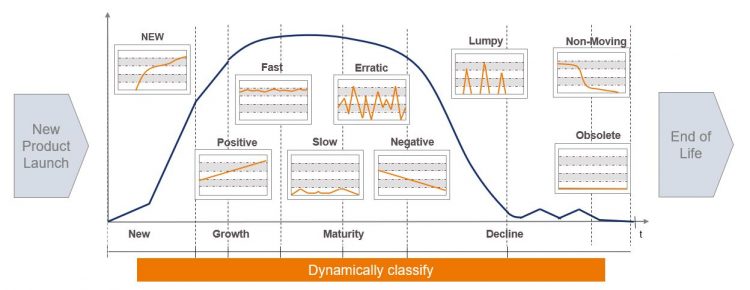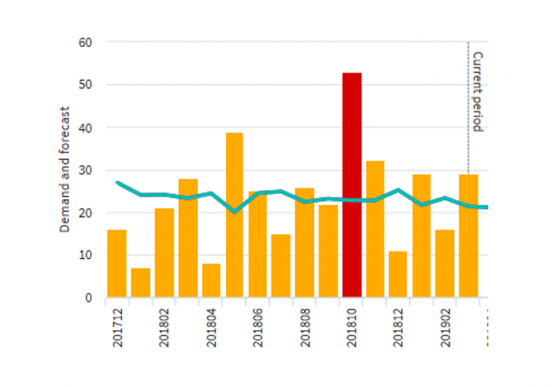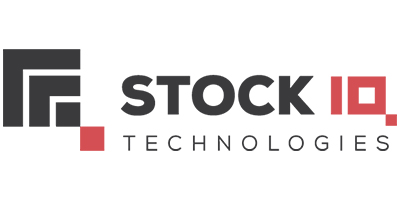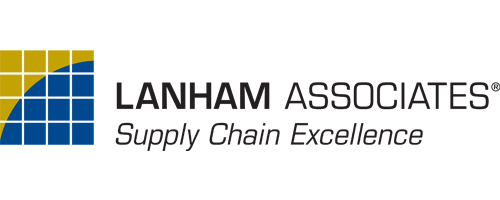
The effects of COVID-19 have put supply chain management (SCM) teams well and truly in the spotlight since they play a crucial role in ensuring business continuity for many organizations across the US.
Many businesses are turning to technology to support their operations and embracing digitalization to help overcome COVID-19 challenges. In this blog series, we look at how inventory optimization tools, such as EazyStock, can support inventory management teams.
This is our second post of this 4-part series. Here, we’ll review the demand forecasting challenges brought about by COVID-19 and how SCM teams can use inventory optimization to find solutions.
COVID-19 and Demand Forecasting Challenges
Within weeks of COVID-19 being reported, supply and demand across the globe were affected, and SCM teams had to move fast to manage the crisis. While some businesses saw dramatic rises in their demand, others saw their sales disappear overnight. As people go back to work and a “new normal” is established, don’t be fooled into thinking that customer behavior will quickly return to its former ways. Unpredictable demand is here to stay, as governments across the globe modify social distancing policies (potentially easing and re-introducing lockdown as they go).
Without a crystal ball to predict the future, demand forecasting will remain very difficult. Inventory management teams, therefore, need to ensure they have the best tools and forecasting processes for the job.
A good starting point is to invest in a statistical demand forecasting tool that can continually analyze and adapt to the latest market conditions. This kind of software will help you understand how volatile your demand is and adjust your replenishment parameters as needed. It can also quickly identify trends in customer behavior and help you respond accordingly.
Why 30-day Rolling Average Forecasts will Fail
COVID-19 has caused erratic customer behavior. Any inventory manager, therefore, using a basic 30-day moving average to calculate demand will find it almost impossible to generate an accurate forecast. This is because a 30-day rolling average forecast is only suitable for inventory items that have stable demand, where the previous 30 days demand is a good indicator of the future forecast period.
However, right now, very few items have stable demand – like PPE, fitness equipment, DIY items, or home furnishings. Even goods with virtually no demand, such as those linked to aviation, will experience fluctuating demand patterns as the industry begins to recover.
Forecasting models, therefore, need to account for a range of demand patterns and treat items differently, depending on the type of demand they’re experiencing.
EazyStock does this by analyzing the demand patterns of all your stock items and assigning each of them to one of nine different demand types. These are based on an item’s position in its product lifecycle. In today’s climate, many items will move around this lifecycle; for example, some inventory items in the automotive industry may recently have moved overnight from growth and maturity to decline, but very soon may return to the growth phase, as sales pick back up.

With demand types assigned, the software then uses the most appropriate statistical algorithm to calculate demand, so every item can be treated differently. For example, items with stable demand will be assigned one algorithm, while those with lumpier or slow-moving demand will use a more suitable formula.
Reacting to Demand Trends Caused by COVID-19
Going forward, having the ability to monitor demand trends will be key to ensuring stock levels match your customers’ requirements. For example, when restaurants reopen the demand for napkins will begin to rise, while as the threat of COVID-19 diminishes, the sale of hand sanitizers will fall.
Demand trends will move fast, and inventory managers using manual forecasting will get left behind. In contrast, a demand forecasting tool will review projections regularly to ensure they reflect the marketplace. With up-to-date forecasts, inventory management teams can then react quickly, maximizing sales opportunities but equally preventing a build-up of excess stock.
Combining Demand Forecasting Technology with Human Insights
When demand is unstable it’s wise to use qualitative forecast data, or human insights, to augment quantitative inventory forecasts for the most realistic demand projections possible. A good forecasting tool like EazyStock will provide the base demand forecast. You can then add qualitative information to this, such as feedback from your sales teams, market intelligence, and insights from your customers.
Alleviating Inaccurate Demand Due to COVID-19
Unfortunately, with so many unpredictable events taking place, producing forecasts with 100% accuracy is going to be extremely challenging. Inventory management teams, therefore, need to find ways to spot when forecasts are inaccurate and put safety nets in place to help prevent consequential stockouts or increases in surplus inventory. Here are some ways inventory optimization software can help:
1. Ongoing demand tracking
EazyStock’s demand-to-date alerts track your actual demand throughout the forecast period and alert you when it’s deviating significantly from its projection. You can then investigate the cause, keep an eye on the items, and adjust reordering if needed.
2. Demand outliers

At the end of a forecast period, EazyStock compares actual demand against its forecast and highlights extreme variances e.g demand outliers. You can then investigate the reasons behind the data and decide whether to include the outlier in your next forecast, which, in turn, will update replenishment parameters.
3. Risk of runout
EazyStock generates a daily risk of runout report, that compares the forecasts of all stock items to current stock levels (including stock in transit) and supplier lead times and alerts you to potential stockouts. You then have the information to manage by exception, delving into the detail of each item and confirming if an order should be placed.
It’s also important to identify items that are the most critical to your supply chain e.g those that you rely on to keep production flowing or that your customers can’t be without. In EazyStock this list can be uploaded and flagged so items can not only be more closely scrutinized but also different replenishment parameters can be assigned to help ensure availability e.g increased safety stock levels, more sensitive stockout alerts, etc.
4. Safety stock
Safety stock is a great way to help alleviate issues with demand and supply. When using an inventory optimization tool such as EazyStock, safety stock levels will dynamically be set based on a wide range of factors, such as an item’s demand type, it’s forecast, supplier lead times and your target service levels (stock availability). During times of unstable demand, safety stock levels are often increased to help mitigate unexpected rises in demand or delays to supply.
Summary
The COVID-19 pandemic is here to stay for the foreseeable future, affecting consumer behavior like never before. There’s no denying that even with inventory optimization software, demand forecasting is going to be challenging throughout 2020 and beyond. However, inventory management teams that have automation to support their efforts will no doubt be best prepared for the task ahead. Using EazyStock, your business will have a powerful demand forecasting engine that will do all forecasting calculations in the background while your team focuses on your customers and suppliers. In addition, you’ll have an arsenal of functionality to help prevent stockouts from occurring and stop inventory building up, helping protect your cashflow.
If you’d like to know more about how EazyStock can support your inventory management processes, please contact the team – we’d be happy to discuss your needs.
This blog is syndicated from our ISV partner Eazystock and originally appeared at https://www.eazystock.com/blog/overcoming-demand-forecasting-challenges-covid-19/.






